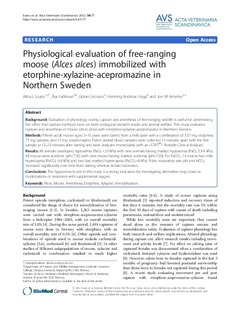Physiological evaluation of free-ranging moose (Alces alces) immobilized with etorphine-xylazine-acepromazine in Northern Sweden
Journal article, Peer reviewed
Permanent lenke
http://hdl.handle.net/11250/134510Utgivelsesdato
2012Metadata
Vis full innførselSamlinger
Originalversjon
Evans, A., Fahlman, Å., Ericsson, G., Haga, H. A., & Arnemo, J. M. (2012). Physiological evaluation of free-ranging moose (Alces alces) immobilized with etorphine-xylazine-acepromazine in Northern Sweden. Acta Veterinaria Scandinavica, 54(77). DOI: 10.1186/1751-0147-54-77 http://dx.doi.org/10.1186/1751-0147-54-77Sammendrag
Background
Evaluation of physiology during capture and anesthesia of free-ranging wildlife is useful for
determining the effect that capture methods have on both ecological research results and
animal welfare. This study evaluates capture and anesthesia of moose (Alces alces) with
etorphine-xylazine-acepromazine in Northern Sweden.
Methods
Fifteen adult moose aged 3–15 years were darted from a helicopter with a combination of
3.37 mg etorphine, 75 mg xylazine, and 15 mg acepromazine. Paired arterial blood samples
were collected 15 minutes apart with the first sample at 15–23 minutes after darting and were
analyzed immediately with an i-STAT®1 Portable Clinical Analyzer.
Results
All animals developed hypoxemia (PaO2 <10 kPa) with nine animals having marked
hypoxemia (PaO2 5.5-8 kPa). All moose were acidemic (ph<7.35) with nine moose having
marked acidemia (pH<7.20). For PaCO2, 14 moose had mild hypercapnia (PaCO2 6-8 kPa)
and two had marked hypercapnia (PaCO2>8 kPa). Pulse, respiratory rate, pH and HCO3
increased significantly over time from darting whereas lactate decreased.
Conclusions
The hypoxemia found in this study is a strong indication for investigating alternative drug
doses or combinations or treatment with supplemental oxygen.
